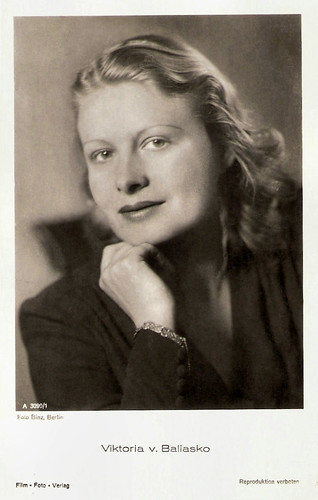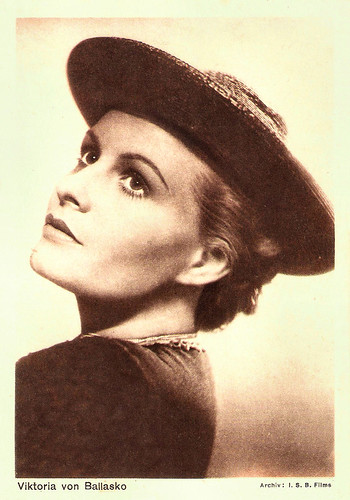
German postcard by Ross Verlag, no. A 1373/1, 1937-1938. Photo: Atelier Willott, Berlin.

German postcard by Ross Verlag, no. A 2454/1, 1939-1940. Photo: Sandau / Tobis.
One of the finest German sound films ever made
Viktoria von Ballasko was born Viktoria Maria Franziska Ballasko in 1909 in Vienna, Austria-Hungary (now Austria). She was an officer's daughter. After high school, she trained at Vienna's Akademie für Darstellende Kunst (Academy of Performing Arts in Vienna).
From 1929 to 1931, she first acted on stage at the Stadttheater in Bern, Switzerland, in 1929. There she appeared as Gretchen in 'Faust'. From 1931 to 1932, she played at the Chemnitz Stadttheater, then in Wroclaw, Vienna, Stuttgart, and Munich. From 1935 she appeared at the Berliner Theater am Schiffbauerdamm.
She made her film debut in the Western Der Kaiser von Kalifornien/The Emperor of California (Luis Trenker, 1936), starring Luis Trenker as German pioneer Johann August Suter, who was looking for luck in America at the beginning of the 19th century. It was the first Western made in Nazi Germany. Some exterior scenes were even shot on location in the United States at Sedona, Arizona, the Grand Canyon and Death Valley in California. Von Ballasko played her first leading role in Kinderarzt Dr. Engel/Dr. Engel: Child Specialist (Johannes Riemann, 1936) with Paul Hörbiger.
Another interesting film was the drama Heiratsschwindler/The Marriage Swindler (Herbert Selpin, 1938), starring Eduard von Winterstein. The film was directed by Selpin for the small studio A.B.C.-Film and distributed by the major company Tobis Film. Heiratsschwindler's neorealism and pessimistic tone were a sharp change from Selpin's recent work which had been dominated by musicals, comedies, and society dramas and was extremely rare in the Nazi era when German cinema strove to be light and entertaining. The film had trouble with the censors, and its release was delayed. It has been described as "One of the finest German sound films ever made" (in Bergfelder, Tim; Street, Sarah, eds. (2004). 'The Titanic in Myth and Memory: Representations in Visual and Literary Culture', p. 122).
Viktoria von Ballasko then appeared in the Nazi Propaganda film Robert Koch, der Bekämpfer des Todes/Robert Koch (Hans Steinhoff, 1939), starring Emil Jannings. The film was a biopic of the German pioneering microbiologist Robert Koch (1843-1910), who experimented on colonial African subjects.

German postcard by Film-Foto-Verlag, no. A 3090/1, 1941-1944. Photo: Binz, Berlin.

German postcard by Film-Foto-Verlag, no. A 3950/1, 1941-1944. Photo: Binz / Bavaria Filmkunst.
Horst Buchholz's mother
On-screen, Viktoria von Ballasko was often typecast as devoted, long-suffering or self-sacrificing wives and daughters, very much in keeping with the prevailing national socialist ideals of femininity. Her films included Mann für Mann/Man for Man (Robert A. Stemmle, 1939), and Heimaterde/Home Earth (Hans Deppe, 1941) with Viktor Staal.
Viktoria von Ballasko failed to rekindle her film career in the aftermath of World War II. From 1946 she played at the Berlin Comedy and appeared as Luise in 'Kabale und Liebe'. She worked for a while as a radio actress and was also briefly active as a voice-over artist, including dubbing for Joan Fontaine in Alfred Hitchcock's Suspicion (1941).
Then, together with Udo Vietz, she wrote the screenplay for the short documentary Anmut und Kraft/Grace and Strength before she got offers as an actress again. Among her later films were the DEFA production Unser täglich Brot/Our Daily Bread (Slatan Dudow, 1949) and the crime drama Die Schuld des Dr. Homma/The Guilt of Doctor Homma (Paul Verhoeven, 1951), starring Werner Hinz and Ilse Steppat.
She also played Horst Buchholz's mother in Die Halbstarken/The Hooligans/Wolfpack (Georg Tressler, 1956), one of the first juvenile delinquency films in post-war West Germany. Her final film was Made in Germany (Wolfgang Schleif, 1957) with Winnie Markus and Carl Raddatz.
Viktoria von Ballasko died in 1976 in West Berlin, West Germany. She was married twice. Her first husband was dubbing author and director Kurt Werther. Since 1949, she was married to Curt Behrendt. The grave of Viktoria von Ballasko is in the cemetery of the Giesensdorfer Dorfkirche in Berlin.

Austrian postcard by Eberle Verlag, Wien, no. 38. Photo: Archiv I.S.B. Films.
Sources: Stephanie d'Heil (Steffi-Line - German), Wikipedia (German and English), and IMDb.
This post was last updated on 2 May 2023.
No comments:
Post a Comment